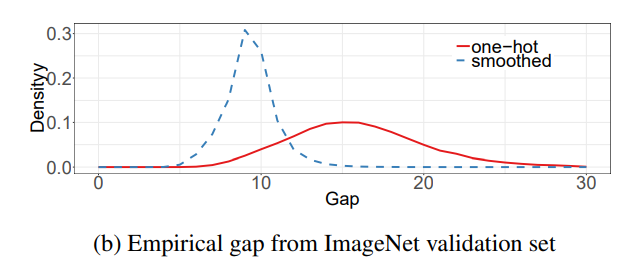浅谈LabelSmooth两种实现及推导
【GiantPandaCV导语】
因为最近跑VIT的实验,所以有用到timm的一些配置,在mixup的实现里面发现labelsmooth的实现是按照最基本的方法来的,与很多pytorch的实现略有不同,所以简单做了一个推导。
一、交叉熵损失(CrossEntropyLoss)
先简单讲一下交叉熵损失,也是我们做分类任务里面最常用的一种损失,公式如下:
这里的 表示的是模型输出的logits后经过softmax的结果,shape为 , 表示的是对应的label,经常用onehot来表示,pytorch版本可以使用scalar表示,shape为 ,这里 表示为batchsize, 表示为向量长度。
可以简单拆解为如下:
log_softmax
这个很简单,就是做softmax后取对数,公式如下:
NLLloss
这个玩意的全程叫做negative log-likelihood(负对数似然损失), 简单解释下: 假设需要求解一个分布 ,由于未知其表达式,所以先定义一个分布 ,通过 来使得 靠近 的分布。这里采用最大似然估计来进行求解, ,不断的更新参数 使得 来自 的样本 在 中的概率越来越高。但是有个问题,连乘对于求导不友好,计算也过于复杂,所以可以对其取对数,有
最大化对数似然函数就等效于最小化负对数似然函数,所以加个负号,公式如下:
由于求loss的时候,采用的是onehot形式,除去当前类别为1其余都为0,所以有:
这个形式就和交叉熵形式一致,所以NLLLoss也叫CrossEntropyLoss。
二、LabelSmooth
由于Softmax会存在一个问题,就是Over Confidence,会使得模型对于弱项的照顾很少。LabelSmooth的作用就是为了降低Softmax所带来的的高Confidence的影响,让模型略微关注到低概率分布的权重。这样做也会有点影响,最终预测的时候,模型输出的置信度会稍微低一些,需要比较细致的阈值过滤。

假设 ,表示对标签进行平滑的数值,那么就有
这里 classes表示类别数量, target表示当前的类别,带有labelsmooth的CELoss就变成了:
相比原始的CELoss,LabelSmoothCELoss则是每一项都会参与到loss计算。
三、公式推导
# labelsmooth
import torch
import torch.nn as nn
import torch.nn.functional as F
class LabelSmoothingCrossEntropy(nn.Module):
"""
NLL loss with label smoothing.
"""
def __init__(self, smoothing=0.1):
"""
Constructor for the LabelSmoothing module.
:param smoothing: label smoothing factor
"""
super(LabelSmoothingCrossEntropy, self).__init__()
assert smoothing < 1.0
self.smoothing = smoothing
self.confidence = 1. - smoothing
def forward(self, x, target):
logprobs = F.log_softmax(x, dim=-1)
nll_loss = -logprobs.gather(dim=-1, index=target.unsqueeze(1))
nll_loss = nll_loss.squeeze(1)
smooth_loss = -logprobs.mean(dim=-1)
loss = self.confidence * nll_loss + self.smoothing * smooth_loss
return loss.mean()
可以看到这个code的实现和公式有点出入,第一部分是self.confidence * nll_loss, 第二部分是self.smoothing * smooth_loss。我们将其展开为:
假设 k为target,那么对于onehot来说除了 以外均为0,所以有:
进一步有组合 项:
最后可以写成矩阵点乘的形式:
我们表示 为LabelSmooth后的标签 ,和第二节中的设定对齐,所以得到的Loss就是原本的表达式:
与之对应的timm中的mixup部分的LabelSmoothCELoss代码如下:
def one_hot(x, num_classes, on_value=1., off_value=0., device='cuda'):
x = x.long().view(-1, 1)
return torch.full((x.size()[0], num_classes), off_value, device=device).scatter_(1, x, on_value)
def mixup_target(target, num_classes, lam=1., smoothing=0.0, device='cuda'):
off_value = smoothing / num_classes
on_value = 1. - smoothing + off_value
y1 = one_hot(target, num_classes, on_value=on_value, off_value=off_value, device=device)
y2 = one_hot(target.flip(0), num_classes, on_value=on_value, off_value=off_value, device=device)
return y1 * lam + y2 * (1. - lam)
四,总结
LabelSmooth可以用来标签平滑,从公示推导方面来讲,也可以充当正则的作用,尤其是针对难分类别的情况下,效果会表现更好一些。

